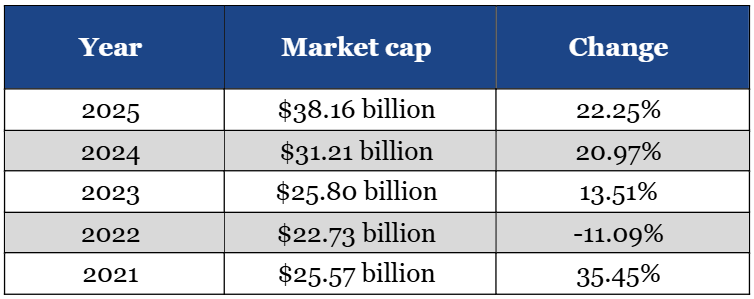Looking for guidance on National Bank of Canada stock? Get key information to better advise your clients and improve their investment strategies

Updated: June 30, 2025
Major financial institutions like banks are essential businesses in any economy. As such, it’s not surprising that their stocks are among the most stable investments. While they still have inherent risk and volatility, savvy investors prefer to hold bank stocks as they often appreciate and hold their value over time. They can even be resilient in economic downturns.
Bank stocks like those of the Big Five banks are some of the most reliable and favoured investments in Canada. But what about other bank stocks apart from the Big Five? Can they be viable investments as well? For instance, what about the National Bank of Canada stock? In this article, Wealth Professional Canada will shed light on its bank stock and more.
A look at National Bank of Canada stock (TSX:NA)
Here’s a look at the National Bank of Canada’s stock indicators:
1. Market cap
As of 2025, the National Bank of Canada has a market capitalization of $38.16 billion. Let’s look at its market cap performance for the past five years:

National Bank of Canada’s market cap dropped to $22.73 billion in 2022, an 11.09% decline from 2021. This dip was mainly caused by trading revenue losses in the fourth quarter of that year.
In September 2022, markets dropped sharply after a budget proposal in the United Kingdom triggered panic. This led to the resignation of former UK Prime Minister Liz Truss. The National Bank of Canada attributed the fall in net interest income to these events.
Despite this, the bank rebounded strongly in the following years: rising to $25.80 billion in 2023 and reaching $38.16 billion in 2025.
Market cap fluctuations
Your clients should note that fluctuations in market caps can be due to various factors. The banking sector can be affected by the following:
- inflation
- company performance
- changes in technology
- changes in government policy
- other local or global events
Looking at the bank’s market cap history, it can be gleaned that the National Bank of Canada stock tends to recover quickly after downturns. Even when its market cap dips, it has shown signs of recovery in the following years.
This suggests some resilience, but future performance depends on changes in market conditions.
2. P/B value ratio: 2.10
With a P/B value ratio of 2.10, we can conclude that the stock is quite overvalued. Ideally, a good stock should have a P/B value of 1 or lower, indicating that it’s a stock that’s selling for less.
National Bank of Canada stock’s P/B value is still lower than the acceptable limit of 3.0. So, even if it appears to be overvalued, the stock is still viable. A P/B ratio above 1 might suggest that the market values the bank higher than its book value.
Still, it's advisable to consider other factors like earnings growth and risk when evaluating investment opportunities.
3. P/E ratio: 12.4
With a P/E ratio of 12.4, the National Bank of Canada stock is deemed viable. The average P/E ratio ranges from 20 to 25 depending on the industry. Any value lower than that indicates a good stock that is not overvalued.
4. Dividend yield: 3.76%
Typically, a dividend yield of 2 percent to 6 percent is considered good. At 3.76 percent, the National Bank of Canada stock is well within the range of being an acceptable investment.
However, your clients should always look at other stock indicators to decide if the dividend yield does make it a good investment.
History of National Bank of Canada
As with most of the big banks of Canada, National Bank of Canada’s origins date back hundreds of years. In 1859, French-speaking businessmen in Ontario and Québec were keen on establishing a local bank, so they persuaded the provincial legislature to create a law for this exact purpose. On May 4, 1859, the Banque Nationale was founded.
Some years after, Banque Nationale had terrible losses during the banking crisis sparked by the financial panic of 1873 and of 1884. However, the bank managed to survive and continued to operate.
But in the 1930s, Banque Nationale again came under severe financial stress due to the Great Depression. This time, a merger was arranged with Banque d’Hochelaga with the assistance of the province's legislature to strengthen the bank.
The then-merged bank was renamed as "Banque Canadienne Nationale" (BCN), which in English translates to "Canadian National Bank".
From BCN to the National Bank of Canada
In November 1979, BCN and its rival Provincial Bank of Canada agreed to a merger. The two banks decided to rebrand the new resulting bank into "National Bank of Canada". This was one of the largest bank mergers of that time.
In the 1980s, the newly founded National Bank of Canada continued to grow via several acquisitions, including brokerage firm Lévesque Beaubien and Geoffrion Leclerc only a year later. These M&As created Lévesque Beaubien Geoffrion.
Headquartered in Montréal, National Bank of Canada is the sixth-largest commercial bank in the country. It operates branches across most Canadian provinces and serves approximately 2.4 million personal clients.
Within Québec, National Bank holds the position of the largest bank and ranks as the second-largest financial institution in the province, following the Desjardins Group.
What is National Bank of Canada’s stock split?
The National Bank of Canada has had an instance of a stock split in its long history. It was done on February 14, 2014 to make National Bank of Canada stock more affordable and attractive to investors.
National Bank’s stock split was a 2-for-1, effectively doubling each share of stock already in the hands of investors.
Is National Bank of Canada a good stock to buy?
If your clients are considering buying National Bank of Canada stock, tell them about the bank stock’s performance. This will help them realize if it aligns with their risk appetite, time horizon, and financial goals.
This bank stock does offer steady dividends and long-term growth, but like any investment, it comes with pitfalls. As such, it’s vital for your clients to review the National Bank of Canada stock’s recent movements before making any decisions.
What is the share price of National Bank of Canada?
National Bank of Canada’s stock price is at a modest $133.80 per share (as of last trading date), making it a decent entry into investing in bank stock. This bank is based in Québec, minimizing its exposure to the national mortgage market, and reducing its volatility.
How often does NA pay dividends?
According to its website, the National Bank of Canada pays dividends quarterly, as and when declared by the board of directors. Payments are made on the first day of February, May, August, and November each year, unless otherwise stated.
Watch this video to learn about the latest earnings results and dividend raise announcement from the National Bank of Canada:
How safe is National Bank of Canada?
The National Bank of Canada is considered a safe and stable financial institution. It holds positive credit ratings from major agencies with a stable outlook.
While external factors like trade tensions can pose risks, the National Bank of Canada's financial position and prudent management help mitigate potential impacts.
Apart from being less exposed to mortgage renewals, their stock has a low P/E ratio with a good dividend yield. The National Bank of Canada takes a conservative and defensive philosophy, especially when it comes to market corrections. Its management is comprised of a team with a wealth of experience, and one of its most tenured members was promoted to chief risk officer.
Overall, National Bank of Canada stock can be a safe and reliable long-term investment for your clients based on their performance over the years.
Should your clients invest in National Bank of Canada stock?
When it comes to deciding whether National Bank of Canada stock is worth one’s time and money, your clients should first determine their investment goals. Next, they should look at its stock price changes and indicators to determine whether it fits their financial plans.
As discussed above, the National Bank of Canada has shown solid performance, making it a viable option for your clients. Over the past year, its stock price has increased by around 13 percent. Plus, it has more than doubled in value when looking at its 5-year performance.
If your clients are looking for long-term growth and stability, this bank stock presents a compelling choice. It also ranks sixth among the best bank stocks to invest in Canada and has consistently delivered dividends along with positive financial results.
Check out our Investor Resources page for other overviews of bank stocks that your clients can invest in.



